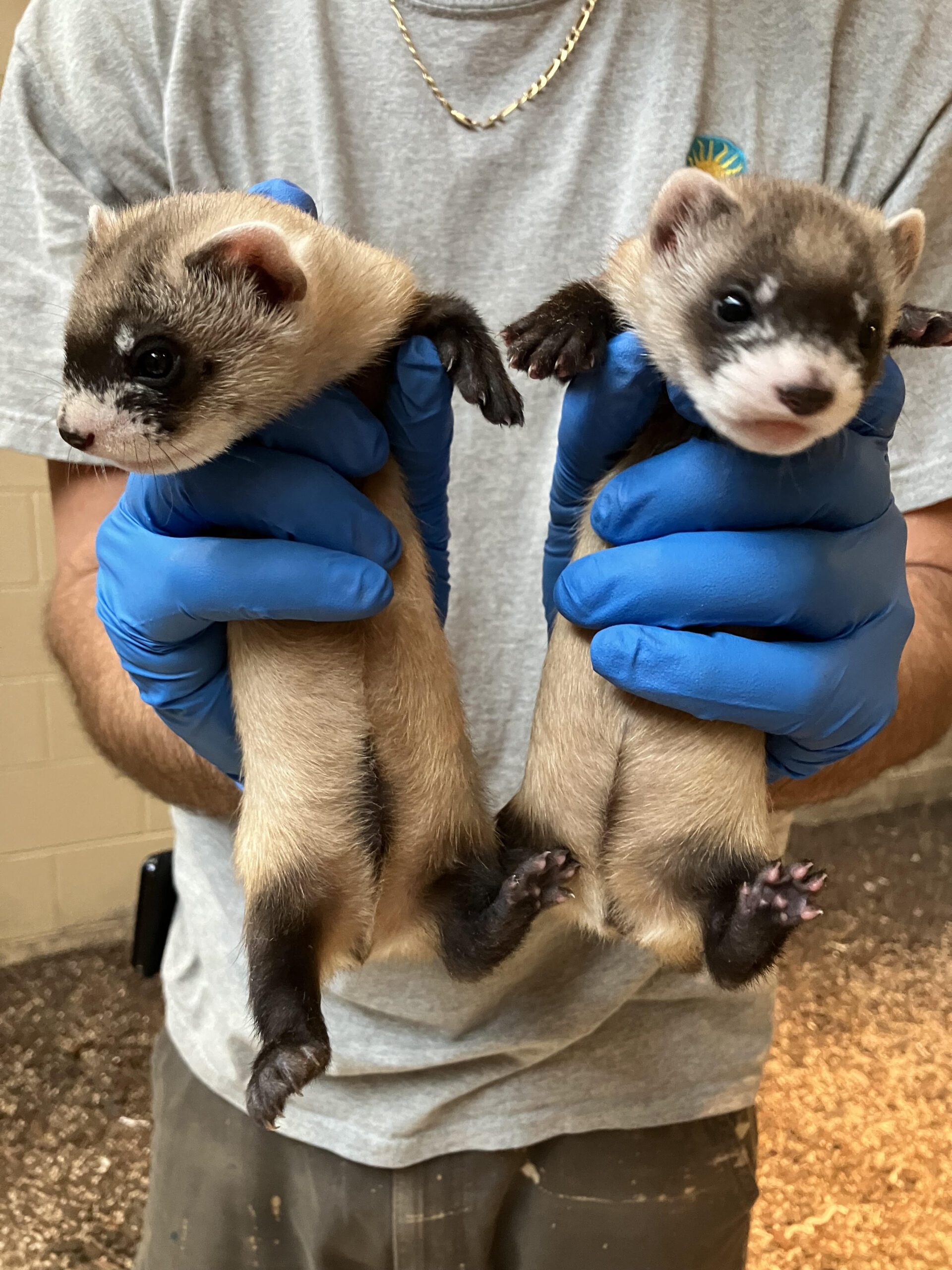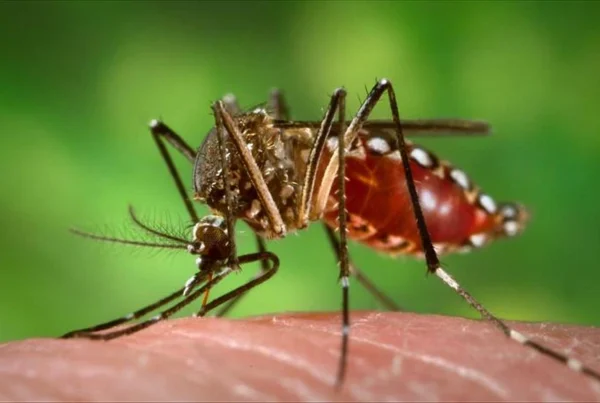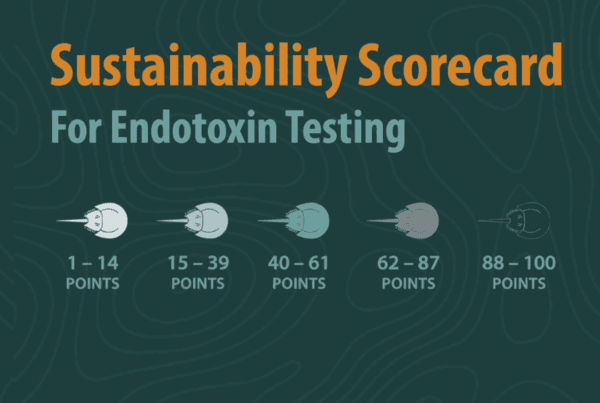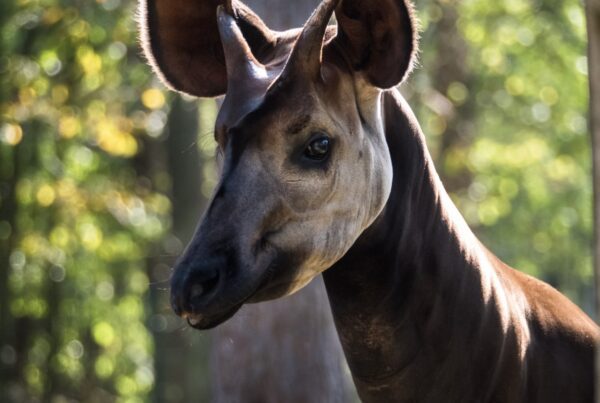Cloned black-footed ferret Antonia's kits at three weeks old, on July 9, 2024. Smithsonian’s National Zoo and Conservation Biology Institute.
Antonia, a cloned black-footed ferret at the Smithsonian’s National Zoo and Conservation Biology Institute, has produced two healthy offspring that will help build genetic diversity in their recovering population
Story by Margherita Bassi, Smithsonian Magazine
From the Article
In a victory for conservation, a cloned endangered animal has birthed healthy offspring for the first time in the United States. The black-footed ferret, named Antonia, is also the first cloned ferret to give birth worldwide.
Antonia produced two adorable kits at the Smithsonian’s National Zoo and Conservation Biology Institute (NZCBI) in Front Royal, Virginia, earlier this summer. The news marks a groundbreaking achievement in the use of cloning to preserve genetic diversity in endangered species.
“The successful breeding and subsequent birth of Antonia’s kits marks a major milestone in endangered species conservation,” Paul Marinari, senior curator at the Smithsonian’s NZCBI, says in a statement. “The many partners in the Black-footed Ferret Recovery Program continue their innovative and inspirational efforts to save this species and be a model for other conservation programs across the globe.”
Black-footed ferrets, also known as American polecats, are carnivorous relatives of weasels with dark patches around their eyes and paws. They are also one of the most endangered mammals in North America because of habitat loss, diseases and a decline in the population of prairie dogs, their main prey, per Newsweek’s Jess Thomson.

The black-footed ferret kits, named Sibert and Red Cloud, at six weeks old (Smithsonian’s National Zoo and Conservation Biology Institute)
As many as one million black-footed ferrets lived on the continent in the late 1800s, but by the late 1950s, the species was presumed extinct. Scientists discovered a wild population in 1964, but even that group died out, and a captive breeding effort failed. Since a second rediscovery of a wild population in 1981, conservationists have worked hard to conserve the species using traditional breeding programs as well as more innovative technologies, including freezing semen and cloning.
One of the challenges conservationists face when tasked with bringing back a species from the brink of extinction is limited genetic diversity, which leads to inbreeding and can make offspring more vulnerable to issues, including hereditary abnormalities, poor reproductive efficiency and increased mortality rates.
“Genetic diversity is critical for resilience to environmental change,” Megan Owen, vice president of conservation science at the San Diego Zoo Wildlife Alliance, one of the partners in the cloning effort, told the Washington Post’s Dino Grandoni in April. “It’s basically the raw material of adaptive evolution.”
The current population of black-footed ferrets—thousands of which have been reintroduced across the western U.S. since the 1990s—is all descend from just seven individuals, except for a few clones and Antonia’s new offspring. That’s a recipe for genetic bottlenecks that threaten the longevity of the species.
Cue cloning. In 1988, scientists had the foresight to collect tissue samples from a black-footed ferret named Willa after she died and preserve the material in the Frozen Zoo at the San Diego Zoo Wildlife Alliance. Willa never reproduced, so her genetic material was not included in the modern ferret population. Her preserved genes contain three times more genetic diversity than living black-footed ferrets do.
In 2020, scientists created Willa’s first clone via a process called somatic cell nuclear transfer. The technique involved injecting Willa’s genetic material into the egg of a domesticated ferret, which then became a surrogate mother. The domestic ferret birthed Elizabeth Ann, the first cloned ferret in the world, but Elizabeth Ann was unable to reproduce.

Black-footed ferret clone, and new mother, Antonia Roshan Patel / Smithsonian Conservation Biology Institute
Antonia and another black-footed ferret named Noreen were the second and third ferrets cloned from Willa (and, overall, in history). Born in May last year, they are Elizabeth Ann’s “genetic twins,” and their births were announced in April.
Once Antonia reached maturity, she mated with Urchin, a 3-year-old male black-footed ferret also at Smithsonian’s NZCBI. In June, she birthed three offspring in a first for conservation. Though one of them died, the surviving female and male have been meeting their expected developmental milestones. Their names are Sibert and Red Cloud, respectively, and biologists currently have no plans to release either of them into the wild.
“For the first time, we can definitively say that cloning contributed meaningful genetic variation back into a breeding population,” says Ryan Phelan, co-founder and executive director of Revive & Restore, a partner on the cloning project, in a statement. “As these kits move forward in the breeding program, the impact of this work will multiply, building a more robust and resilient population over time.”
With these births, Antonia is the first to restore Willa’s historic genetic diversity back into the black-footed ferret population, demonstrating cloning technology’s potential in endangered animal conservation. With luck, Sibert and Red Cloud will be able to continue her legacy.
About the Program
Since 2013, Revive & Restore and its partners have worked to restore genetic diversity in black-footed ferrets through strategic conservation cloning. We welcomed the world’s first cloned black-footed ferret in 2020, and two additional cloned ferrets in 2023. In June 2024, one of those cloned ferrets gave birth to two healthy kits marking the first time that a cloned endangered species has given birth in a conservation program.
More posts in News & Media







